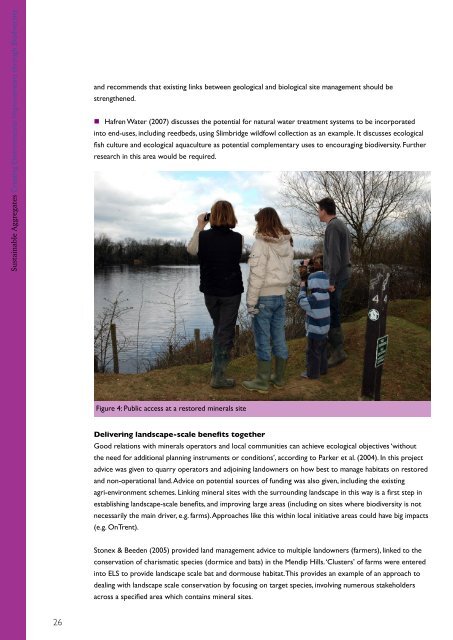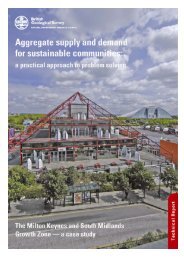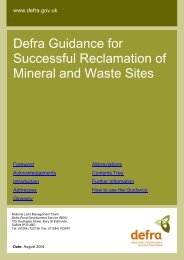creating environmental improvements through biodiversity
creating environmental improvements through biodiversity
creating environmental improvements through biodiversity
You also want an ePaper? Increase the reach of your titles
YUMPU automatically turns print PDFs into web optimized ePapers that Google loves.
Sustainable Aggregates Creating Environmental Improvements <strong>through</strong> Biodiversity<br />
and recommends that existing links between geological and biological site management should be<br />
strengthened.<br />
• Hafren Water (2007) discusses the potential for natural water treatment systems to be incorporated<br />
into end-uses, including reedbeds, using Slimbridge wildfowl collection as an example. It discusses ecological<br />
fish culture and ecological aquaculture as potential complementary uses to encouraging <strong>biodiversity</strong>. Further<br />
research in this area would be required.<br />
Figure 4: Public access at a restored minerals site<br />
Delivering landscape-scale benefits together<br />
Good relations with minerals operators and local communities can achieve ecological objectives ‘without<br />
the need for additional planning instruments or conditions’, according to Parker et al. (2004). In this project<br />
advice was given to quarry operators and adjoining landowners on how best to manage habitats on restored<br />
and non-operational land. Advice on potential sources of funding was also given, including the existing<br />
agri-environment schemes. Linking mineral sites with the surrounding landscape in this way is a first step in<br />
establishing landscape-scale benefits, and improving large areas (including on sites where <strong>biodiversity</strong> is not<br />
necessarily the main driver, e.g. farms). Approaches like this within local initiative areas could have big impacts<br />
(e.g. OnTrent).<br />
Stonex & Beeden (2005) provided land management advice to multiple landowners (farmers), linked to the<br />
conservation of charismatic species (dormice and bats) in the Mendip Hills. ‘Clusters’ of farms were entered<br />
into ELS to provide landscape scale bat and dormouse habitat. This provides an example of an approach to<br />
dealing with landscape scale conservation by focusing on target species, involving numerous stakeholders<br />
across a specified area which contains mineral sites.<br />
26

















